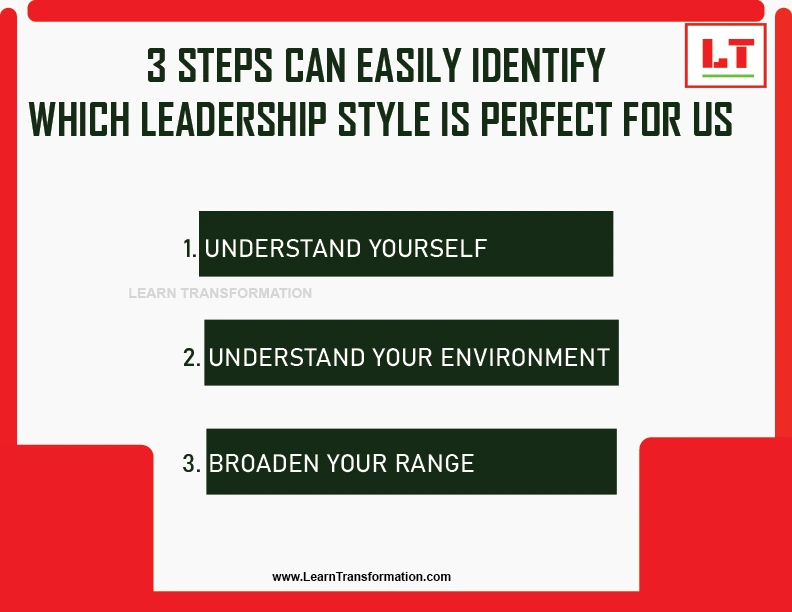People develop their leadership style throughout their careers, and it can extend and change over time. Building your leadership skill is the main thing to being a successful leader. You also need some soft skills, not the least of which is the ability to take on a leadership role.
When you are starting, you may be focused more on finding your place in the corporate world than thinking about your leadership style. But as you move forward, developing an effective leadership style can propel you.
How to find an Effective leadership style for you ?
A leadership style is a leader’s characteristic behaviors when controlling, directing, guiding and managing a group of people. To become a good leader today, we need to know which leadership style is perfect for us. There are three steps from that we can easily identify which style is perfect for us:

1. Understand yourself to know the best leadership style
The first step to building your leadership style is to be aware of your natural strengths and weakness, to build your cognitive self-awareness. This will provide you with a baseline where you feel most comfortable. Becoming more self-aware requires being open to both formal and informal feedback, as well as paying attention to the areas where you struggle the most for noticing when your employees are not relying on you to complete a task.
2. Understand your environment
- Situational awareness
Leaders facing disruptions must be able to interpret their environment, understanding what features present and what implications are they have for the task at hand. It’s making sense of the world. first, you have to experience a given situation in the present and non-judgmental way. Next, you must identify the relevant stimuli from the environment and separate those from the environment.
For example, a leader of a multinational fast-moving consumer goods company found that he was struggling with several complex problems that could benefit from a wider viewpoint. After getting feedback in his annual 360 that he tends to speak more than listen, he realized that moving along the spectrum from a teller to a listener would improve her leadership effectiveness.
Leader’s Tip
Flexibility and versatility: For maximum efficiency, adapt your leadership approach to diverse situations, teams, and individuals.
- Inter and Intrapersonal emotional awareness
A leader needs to develop cognitive empathy, which is an awareness of the emotions of the people around them. This is both a trait and a skill. While some people have natural tendencies to sense others’ emotions, this skill can be improved through focused efforts and practice.
In addition to inter-personal, a leader needs to develop intrapersonal awareness, or the ability to accurately sense one’s emotional state.
Check it out – Decision Making and Problem Solving is Essential Skill for Every Leader
Check out this video:
Leader’s Tip
Ongoing self-improvement: Seek feedback, learn from experience, and seek to better your leadership and expertise.
3. Broaden your range
If you are fortunate, the most appropriate behavior in a given situation falls within your leadership sweet range. In this case, the action is straightforward. However, if the situation calls for behavior beyond your range, then the gap will need to be covered. There are three ways you can take to do this:
A true leader has the confidence to stand alone, the courage to make tough decisions and the compassion to listen to the needs of others. —Douglas MacArthur
- Practice micro behavior – Rather than taking a great step to shift your behavior, you can target micro-behavior that moves you closer to your end goal. A micro-behavior is something small, maybe even seemingly insignificant, but consistent with the direction you want to move.
- Seek out role models – You can often find motivation from someone who possesses different capabilities and can act as a role model for the kinds of behaviours you seek to develop.
- Look inside and outside of your team for help – Sometimes, working to cover the gap between your default style and the most appropriate response would be inefficient in terms of time and effort. In such cases, you must look inside or outside your existing team to fill the gap.
FAQs
How can a leader motivate their team?
Great leaders inspire their team through a combination of positive behaviour, communication and attitude. Great leaders always encourage their employees to continuously develop, remain positive under all circumstances and motivate and inspire their team.
What is a strong leadership style?
A leadership style is a leader’s characteristic behaviors when controlling, directing, guiding and managing a group of people. To become a good leader today, we need to know which leadership style is perfect for us.
Key Takeaways
- There is no such thing as a “perfect” leadership style; good leaders are versatile and capable of utilising several approaches as needed.
- Understanding the situational environment as well as the demands of the team or individuals is critical for selecting and implementing the best leadership technique.
- To inspire and motivate people to achieve goals, emphasise communication, empathy, collaboration, and establishing a healthy work culture.

